ITC571 Project - IoT for Smart Healthcare: Tech, Challenges
VerifiedAdded on 2023/04/25
|5
|2223
|453
Project
AI Summary
This project plan provides a review of the Internet of Things (IoT) in smart healthcare, focusing on the technologies, challenges, and opportunities. It identifies the limitations of using IoT wearable devices in healthcare systems, including concerns about legitimacy, dependability, data security, and privacy. The study explores how these limitations can be mitigated through cloud connectivity and refined methods, while also addressing the security risks associated with unauthorized data sharing. The benefits of IoT wearables, such as providing individuals with better control over their health outcomes and enabling remote monitoring, are discussed. The research methodology involves a positivism philosophy, quantitative data collection, and both primary and secondary data sources. The expected outcome is to provide health organizations with a better understanding of the complexities and impact of IoT technologies in healthcare.
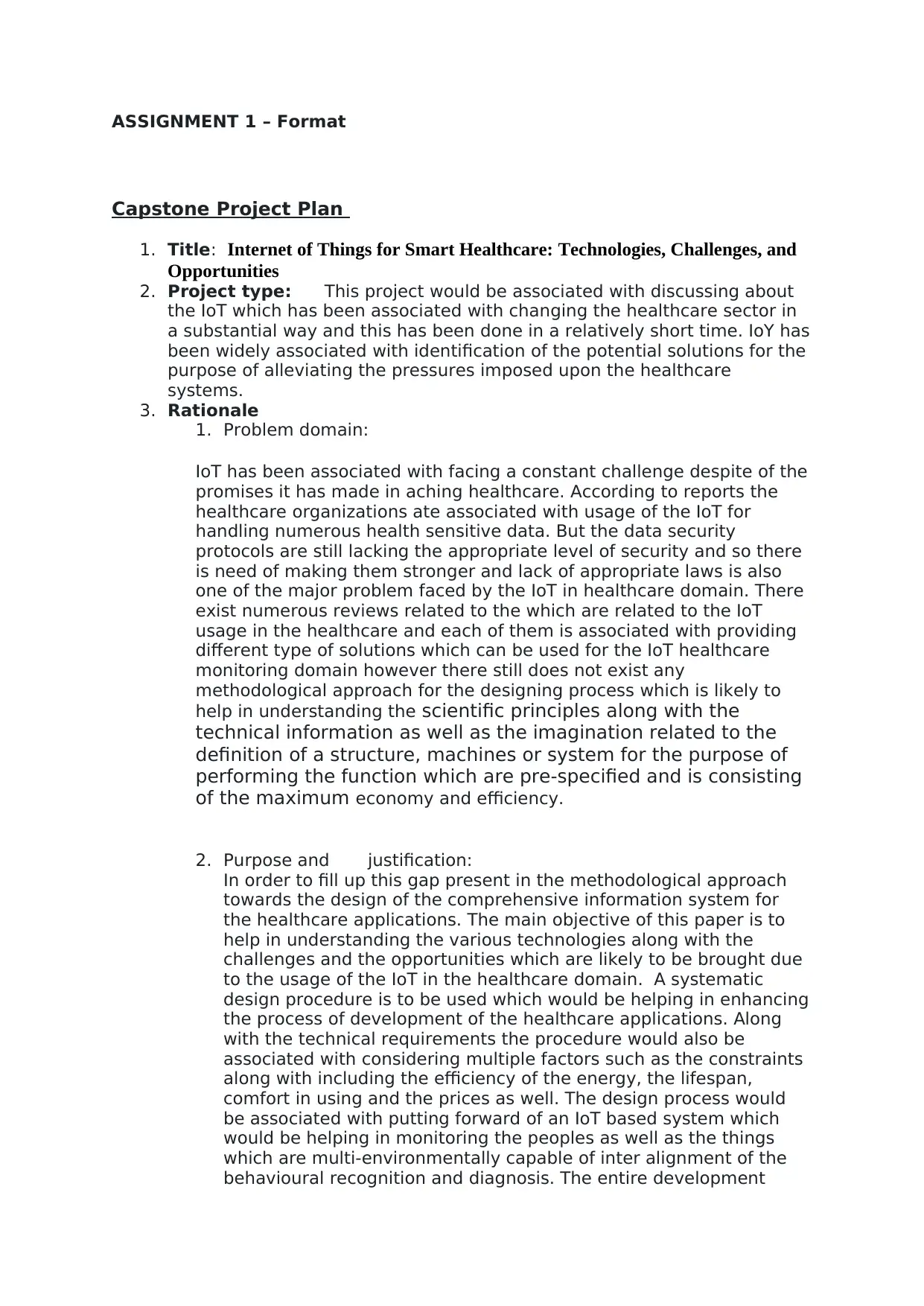
ASSIGNMENT 1 – Format
Capstone Project Plan
1. Title: Internet of Things for Smart Healthcare: Technologies, Challenges, and
Opportunities
2. Project type: This project would be associated with discussing about
the IoT which has been associated with changing the healthcare sector in
a substantial way and this has been done in a relatively short time. IoY has
been widely associated with identification of the potential solutions for the
purpose of alleviating the pressures imposed upon the healthcare
systems.
3. Rationale
1. Problem domain:
IoT has been associated with facing a constant challenge despite of the
promises it has made in aching healthcare. According to reports the
healthcare organizations ate associated with usage of the IoT for
handling numerous health sensitive data. But the data security
protocols are still lacking the appropriate level of security and so there
is need of making them stronger and lack of appropriate laws is also
one of the major problem faced by the IoT in healthcare domain. There
exist numerous reviews related to the which are related to the IoT
usage in the healthcare and each of them is associated with providing
different type of solutions which can be used for the IoT healthcare
monitoring domain however there still does not exist any
methodological approach for the designing process which is likely to
help in understanding the scientific principles along with the
technical information as well as the imagination related to the
definition of a structure, machines or system for the purpose of
performing the function which are pre-specified and is consisting
of the maximum economy and efficiency.
2. Purpose and justification:
In order to fill up this gap present in the methodological approach
towards the design of the comprehensive information system for
the healthcare applications. The main objective of this paper is to
help in understanding the various technologies along with the
challenges and the opportunities which are likely to be brought due
to the usage of the IoT in the healthcare domain. A systematic
design procedure is to be used which would be helping in enhancing
the process of development of the healthcare applications. Along
with the technical requirements the procedure would also be
associated with considering multiple factors such as the constraints
along with including the efficiency of the energy, the lifespan,
comfort in using and the prices as well. The design process would
be associated with putting forward of an IoT based system which
would be helping in monitoring the peoples as well as the things
which are multi-environmentally capable of inter alignment of the
behavioural recognition and diagnosis. The entire development
Capstone Project Plan
1. Title: Internet of Things for Smart Healthcare: Technologies, Challenges, and
Opportunities
2. Project type: This project would be associated with discussing about
the IoT which has been associated with changing the healthcare sector in
a substantial way and this has been done in a relatively short time. IoY has
been widely associated with identification of the potential solutions for the
purpose of alleviating the pressures imposed upon the healthcare
systems.
3. Rationale
1. Problem domain:
IoT has been associated with facing a constant challenge despite of the
promises it has made in aching healthcare. According to reports the
healthcare organizations ate associated with usage of the IoT for
handling numerous health sensitive data. But the data security
protocols are still lacking the appropriate level of security and so there
is need of making them stronger and lack of appropriate laws is also
one of the major problem faced by the IoT in healthcare domain. There
exist numerous reviews related to the which are related to the IoT
usage in the healthcare and each of them is associated with providing
different type of solutions which can be used for the IoT healthcare
monitoring domain however there still does not exist any
methodological approach for the designing process which is likely to
help in understanding the scientific principles along with the
technical information as well as the imagination related to the
definition of a structure, machines or system for the purpose of
performing the function which are pre-specified and is consisting
of the maximum economy and efficiency.
2. Purpose and justification:
In order to fill up this gap present in the methodological approach
towards the design of the comprehensive information system for
the healthcare applications. The main objective of this paper is to
help in understanding the various technologies along with the
challenges and the opportunities which are likely to be brought due
to the usage of the IoT in the healthcare domain. A systematic
design procedure is to be used which would be helping in enhancing
the process of development of the healthcare applications. Along
with the technical requirements the procedure would also be
associated with considering multiple factors such as the constraints
along with including the efficiency of the energy, the lifespan,
comfort in using and the prices as well. The design process would
be associated with putting forward of an IoT based system which
would be helping in monitoring the peoples as well as the things
which are multi-environmentally capable of inter alignment of the
behavioural recognition and diagnosis. The entire development
Paraphrase This Document
Need a fresh take? Get an instant paraphrase of this document with our AI Paraphraser
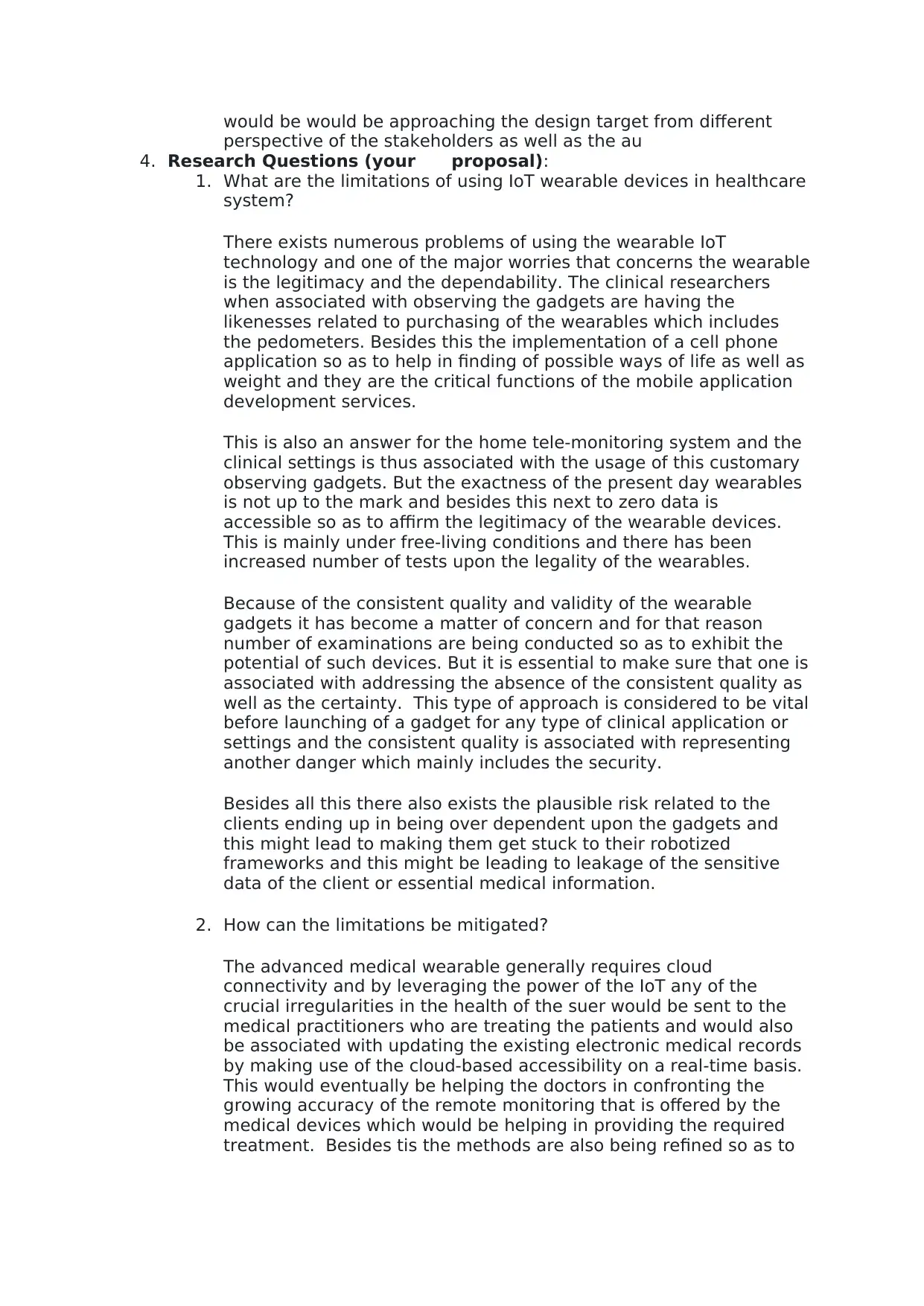
would be would be approaching the design target from different
perspective of the stakeholders as well as the au
4. Research Questions (your proposal):
1. What are the limitations of using IoT wearable devices in healthcare
system?
There exists numerous problems of using the wearable IoT
technology and one of the major worries that concerns the wearable
is the legitimacy and the dependability. The clinical researchers
when associated with observing the gadgets are having the
likenesses related to purchasing of the wearables which includes
the pedometers. Besides this the implementation of a cell phone
application so as to help in finding of possible ways of life as well as
weight and they are the critical functions of the mobile application
development services.
This is also an answer for the home tele-monitoring system and the
clinical settings is thus associated with the usage of this customary
observing gadgets. But the exactness of the present day wearables
is not up to the mark and besides this next to zero data is
accessible so as to affirm the legitimacy of the wearable devices.
This is mainly under free-living conditions and there has been
increased number of tests upon the legality of the wearables.
Because of the consistent quality and validity of the wearable
gadgets it has become a matter of concern and for that reason
number of examinations are being conducted so as to exhibit the
potential of such devices. But it is essential to make sure that one is
associated with addressing the absence of the consistent quality as
well as the certainty. This type of approach is considered to be vital
before launching of a gadget for any type of clinical application or
settings and the consistent quality is associated with representing
another danger which mainly includes the security.
Besides all this there also exists the plausible risk related to the
clients ending up in being over dependent upon the gadgets and
this might lead to making them get stuck to their robotized
frameworks and this might be leading to leakage of the sensitive
data of the client or essential medical information.
2. How can the limitations be mitigated?
The advanced medical wearable generally requires cloud
connectivity and by leveraging the power of the IoT any of the
crucial irregularities in the health of the suer would be sent to the
medical practitioners who are treating the patients and would also
be associated with updating the existing electronic medical records
by making use of the cloud-based accessibility on a real-time basis.
This would eventually be helping the doctors in confronting the
growing accuracy of the remote monitoring that is offered by the
medical devices which would be helping in providing the required
treatment. Besides tis the methods are also being refined so as to
perspective of the stakeholders as well as the au
4. Research Questions (your proposal):
1. What are the limitations of using IoT wearable devices in healthcare
system?
There exists numerous problems of using the wearable IoT
technology and one of the major worries that concerns the wearable
is the legitimacy and the dependability. The clinical researchers
when associated with observing the gadgets are having the
likenesses related to purchasing of the wearables which includes
the pedometers. Besides this the implementation of a cell phone
application so as to help in finding of possible ways of life as well as
weight and they are the critical functions of the mobile application
development services.
This is also an answer for the home tele-monitoring system and the
clinical settings is thus associated with the usage of this customary
observing gadgets. But the exactness of the present day wearables
is not up to the mark and besides this next to zero data is
accessible so as to affirm the legitimacy of the wearable devices.
This is mainly under free-living conditions and there has been
increased number of tests upon the legality of the wearables.
Because of the consistent quality and validity of the wearable
gadgets it has become a matter of concern and for that reason
number of examinations are being conducted so as to exhibit the
potential of such devices. But it is essential to make sure that one is
associated with addressing the absence of the consistent quality as
well as the certainty. This type of approach is considered to be vital
before launching of a gadget for any type of clinical application or
settings and the consistent quality is associated with representing
another danger which mainly includes the security.
Besides all this there also exists the plausible risk related to the
clients ending up in being over dependent upon the gadgets and
this might lead to making them get stuck to their robotized
frameworks and this might be leading to leakage of the sensitive
data of the client or essential medical information.
2. How can the limitations be mitigated?
The advanced medical wearable generally requires cloud
connectivity and by leveraging the power of the IoT any of the
crucial irregularities in the health of the suer would be sent to the
medical practitioners who are treating the patients and would also
be associated with updating the existing electronic medical records
by making use of the cloud-based accessibility on a real-time basis.
This would eventually be helping the doctors in confronting the
growing accuracy of the remote monitoring that is offered by the
medical devices which would be helping in providing the required
treatment. Besides tis the methods are also being refined so as to
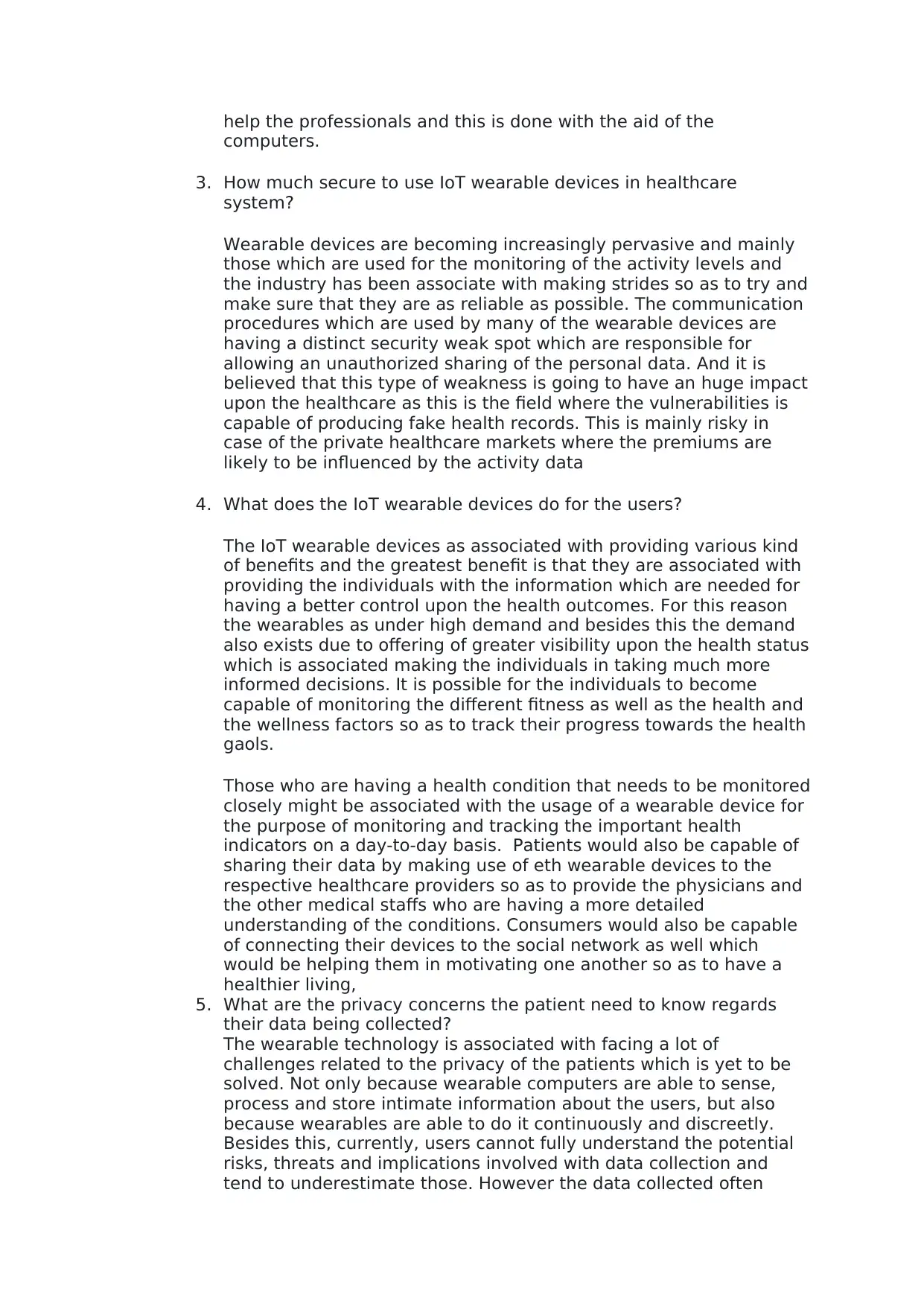
help the professionals and this is done with the aid of the
computers.
3. How much secure to use IoT wearable devices in healthcare
system?
Wearable devices are becoming increasingly pervasive and mainly
those which are used for the monitoring of the activity levels and
the industry has been associate with making strides so as to try and
make sure that they are as reliable as possible. The communication
procedures which are used by many of the wearable devices are
having a distinct security weak spot which are responsible for
allowing an unauthorized sharing of the personal data. And it is
believed that this type of weakness is going to have an huge impact
upon the healthcare as this is the field where the vulnerabilities is
capable of producing fake health records. This is mainly risky in
case of the private healthcare markets where the premiums are
likely to be influenced by the activity data
4. What does the IoT wearable devices do for the users?
The IoT wearable devices as associated with providing various kind
of benefits and the greatest benefit is that they are associated with
providing the individuals with the information which are needed for
having a better control upon the health outcomes. For this reason
the wearables as under high demand and besides this the demand
also exists due to offering of greater visibility upon the health status
which is associated making the individuals in taking much more
informed decisions. It is possible for the individuals to become
capable of monitoring the different fitness as well as the health and
the wellness factors so as to track their progress towards the health
gaols.
Those who are having a health condition that needs to be monitored
closely might be associated with the usage of a wearable device for
the purpose of monitoring and tracking the important health
indicators on a day-to-day basis. Patients would also be capable of
sharing their data by making use of eth wearable devices to the
respective healthcare providers so as to provide the physicians and
the other medical staffs who are having a more detailed
understanding of the conditions. Consumers would also be capable
of connecting their devices to the social network as well which
would be helping them in motivating one another so as to have a
healthier living,
5. What are the privacy concerns the patient need to know regards
their data being collected?
The wearable technology is associated with facing a lot of
challenges related to the privacy of the patients which is yet to be
solved. Not only because wearable computers are able to sense,
process and store intimate information about the users, but also
because wearables are able to do it continuously and discreetly.
Besides this, currently, users cannot fully understand the potential
risks, threats and implications involved with data collection and
tend to underestimate those. However the data collected often
computers.
3. How much secure to use IoT wearable devices in healthcare
system?
Wearable devices are becoming increasingly pervasive and mainly
those which are used for the monitoring of the activity levels and
the industry has been associate with making strides so as to try and
make sure that they are as reliable as possible. The communication
procedures which are used by many of the wearable devices are
having a distinct security weak spot which are responsible for
allowing an unauthorized sharing of the personal data. And it is
believed that this type of weakness is going to have an huge impact
upon the healthcare as this is the field where the vulnerabilities is
capable of producing fake health records. This is mainly risky in
case of the private healthcare markets where the premiums are
likely to be influenced by the activity data
4. What does the IoT wearable devices do for the users?
The IoT wearable devices as associated with providing various kind
of benefits and the greatest benefit is that they are associated with
providing the individuals with the information which are needed for
having a better control upon the health outcomes. For this reason
the wearables as under high demand and besides this the demand
also exists due to offering of greater visibility upon the health status
which is associated making the individuals in taking much more
informed decisions. It is possible for the individuals to become
capable of monitoring the different fitness as well as the health and
the wellness factors so as to track their progress towards the health
gaols.
Those who are having a health condition that needs to be monitored
closely might be associated with the usage of a wearable device for
the purpose of monitoring and tracking the important health
indicators on a day-to-day basis. Patients would also be capable of
sharing their data by making use of eth wearable devices to the
respective healthcare providers so as to provide the physicians and
the other medical staffs who are having a more detailed
understanding of the conditions. Consumers would also be capable
of connecting their devices to the social network as well which
would be helping them in motivating one another so as to have a
healthier living,
5. What are the privacy concerns the patient need to know regards
their data being collected?
The wearable technology is associated with facing a lot of
challenges related to the privacy of the patients which is yet to be
solved. Not only because wearable computers are able to sense,
process and store intimate information about the users, but also
because wearables are able to do it continuously and discreetly.
Besides this, currently, users cannot fully understand the potential
risks, threats and implications involved with data collection and
tend to underestimate those. However the data collected often
⊘ This is a preview!⊘
Do you want full access?
Subscribe today to unlock all pages.

Trusted by 1+ million students worldwide
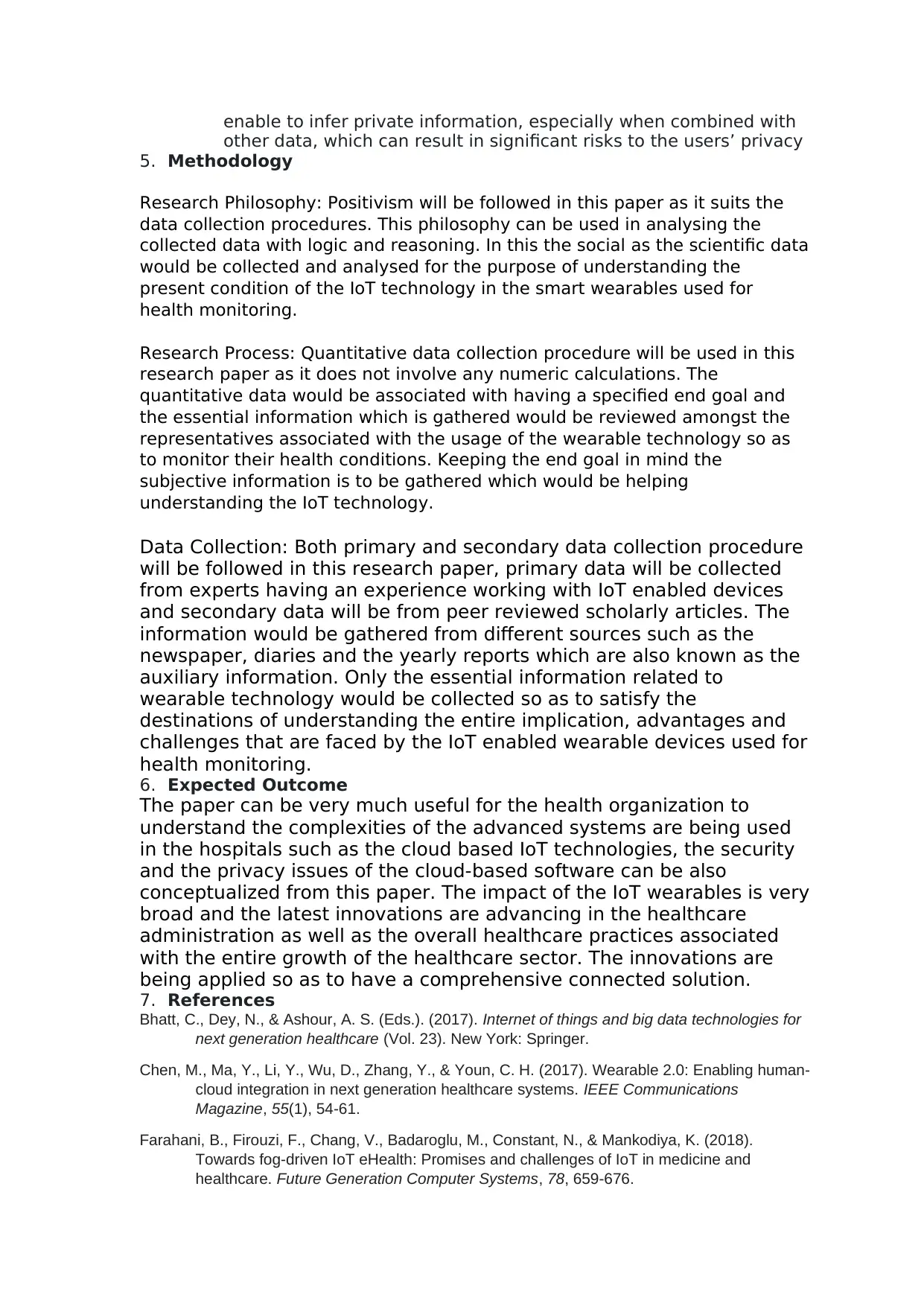
enable to infer private information, especially when combined with
other data, which can result in significant risks to the users’ privacy
5. Methodology
Research Philosophy: Positivism will be followed in this paper as it suits the
data collection procedures. This philosophy can be used in analysing the
collected data with logic and reasoning. In this the social as the scientific data
would be collected and analysed for the purpose of understanding the
present condition of the IoT technology in the smart wearables used for
health monitoring.
Research Process: Quantitative data collection procedure will be used in this
research paper as it does not involve any numeric calculations. The
quantitative data would be associated with having a specified end goal and
the essential information which is gathered would be reviewed amongst the
representatives associated with the usage of the wearable technology so as
to monitor their health conditions. Keeping the end goal in mind the
subjective information is to be gathered which would be helping
understanding the IoT technology.
Data Collection: Both primary and secondary data collection procedure
will be followed in this research paper, primary data will be collected
from experts having an experience working with IoT enabled devices
and secondary data will be from peer reviewed scholarly articles. The
information would be gathered from different sources such as the
newspaper, diaries and the yearly reports which are also known as the
auxiliary information. Only the essential information related to
wearable technology would be collected so as to satisfy the
destinations of understanding the entire implication, advantages and
challenges that are faced by the IoT enabled wearable devices used for
health monitoring.
6. Expected Outcome
The paper can be very much useful for the health organization to
understand the complexities of the advanced systems are being used
in the hospitals such as the cloud based IoT technologies, the security
and the privacy issues of the cloud-based software can be also
conceptualized from this paper. The impact of the IoT wearables is very
broad and the latest innovations are advancing in the healthcare
administration as well as the overall healthcare practices associated
with the entire growth of the healthcare sector. The innovations are
being applied so as to have a comprehensive connected solution.
7. References
Bhatt, C., Dey, N., & Ashour, A. S. (Eds.). (2017). Internet of things and big data technologies for
next generation healthcare (Vol. 23). New York: Springer.
Chen, M., Ma, Y., Li, Y., Wu, D., Zhang, Y., & Youn, C. H. (2017). Wearable 2.0: Enabling human-
cloud integration in next generation healthcare systems. IEEE Communications
Magazine, 55(1), 54-61.
Farahani, B., Firouzi, F., Chang, V., Badaroglu, M., Constant, N., & Mankodiya, K. (2018).
Towards fog-driven IoT eHealth: Promises and challenges of IoT in medicine and
healthcare. Future Generation Computer Systems, 78, 659-676.
other data, which can result in significant risks to the users’ privacy
5. Methodology
Research Philosophy: Positivism will be followed in this paper as it suits the
data collection procedures. This philosophy can be used in analysing the
collected data with logic and reasoning. In this the social as the scientific data
would be collected and analysed for the purpose of understanding the
present condition of the IoT technology in the smart wearables used for
health monitoring.
Research Process: Quantitative data collection procedure will be used in this
research paper as it does not involve any numeric calculations. The
quantitative data would be associated with having a specified end goal and
the essential information which is gathered would be reviewed amongst the
representatives associated with the usage of the wearable technology so as
to monitor their health conditions. Keeping the end goal in mind the
subjective information is to be gathered which would be helping
understanding the IoT technology.
Data Collection: Both primary and secondary data collection procedure
will be followed in this research paper, primary data will be collected
from experts having an experience working with IoT enabled devices
and secondary data will be from peer reviewed scholarly articles. The
information would be gathered from different sources such as the
newspaper, diaries and the yearly reports which are also known as the
auxiliary information. Only the essential information related to
wearable technology would be collected so as to satisfy the
destinations of understanding the entire implication, advantages and
challenges that are faced by the IoT enabled wearable devices used for
health monitoring.
6. Expected Outcome
The paper can be very much useful for the health organization to
understand the complexities of the advanced systems are being used
in the hospitals such as the cloud based IoT technologies, the security
and the privacy issues of the cloud-based software can be also
conceptualized from this paper. The impact of the IoT wearables is very
broad and the latest innovations are advancing in the healthcare
administration as well as the overall healthcare practices associated
with the entire growth of the healthcare sector. The innovations are
being applied so as to have a comprehensive connected solution.
7. References
Bhatt, C., Dey, N., & Ashour, A. S. (Eds.). (2017). Internet of things and big data technologies for
next generation healthcare (Vol. 23). New York: Springer.
Chen, M., Ma, Y., Li, Y., Wu, D., Zhang, Y., & Youn, C. H. (2017). Wearable 2.0: Enabling human-
cloud integration in next generation healthcare systems. IEEE Communications
Magazine, 55(1), 54-61.
Farahani, B., Firouzi, F., Chang, V., Badaroglu, M., Constant, N., & Mankodiya, K. (2018).
Towards fog-driven IoT eHealth: Promises and challenges of IoT in medicine and
healthcare. Future Generation Computer Systems, 78, 659-676.
Paraphrase This Document
Need a fresh take? Get an instant paraphrase of this document with our AI Paraphraser
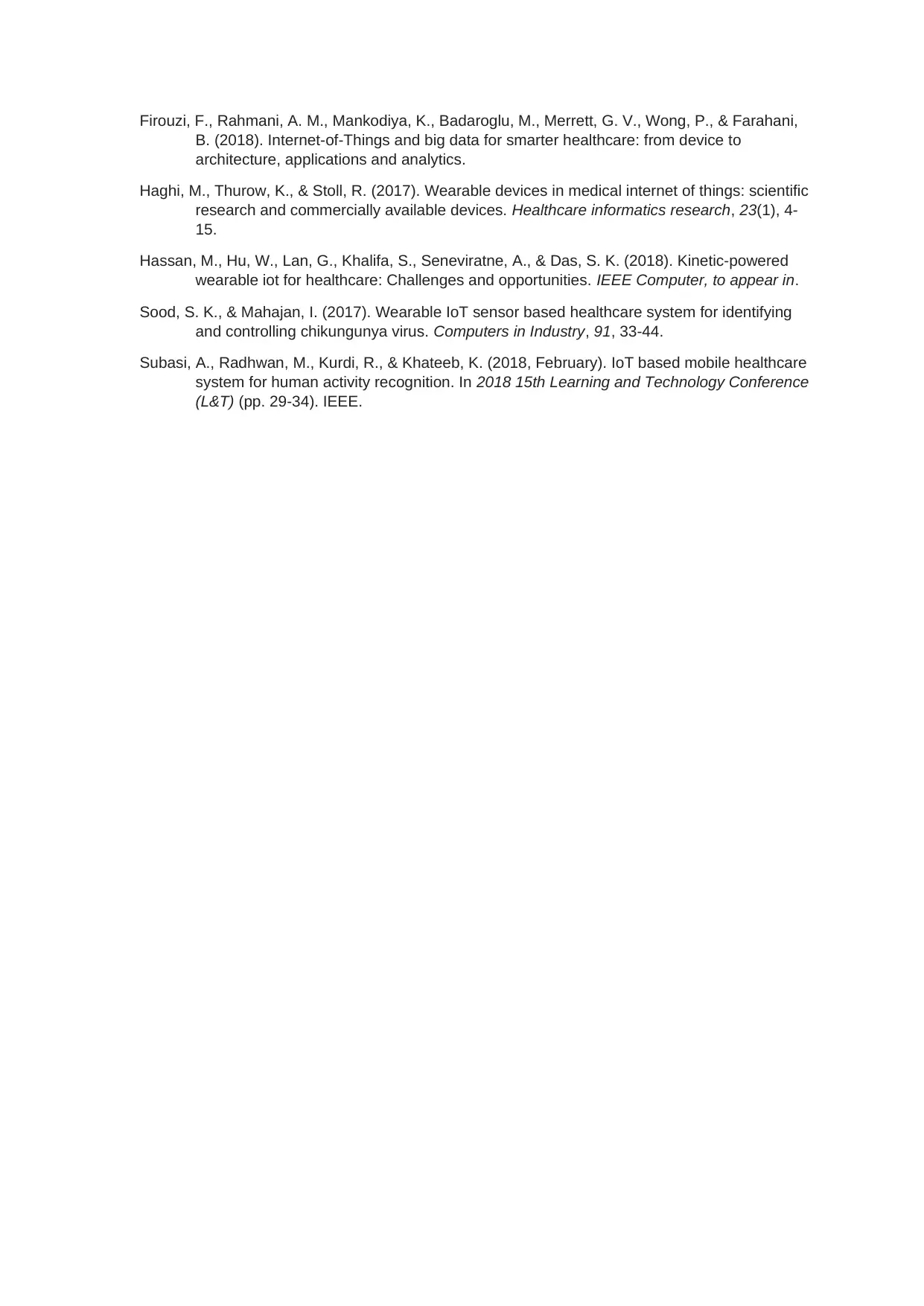
Firouzi, F., Rahmani, A. M., Mankodiya, K., Badaroglu, M., Merrett, G. V., Wong, P., & Farahani,
B. (2018). Internet-of-Things and big data for smarter healthcare: from device to
architecture, applications and analytics.
Haghi, M., Thurow, K., & Stoll, R. (2017). Wearable devices in medical internet of things: scientific
research and commercially available devices. Healthcare informatics research, 23(1), 4-
15.
Hassan, M., Hu, W., Lan, G., Khalifa, S., Seneviratne, A., & Das, S. K. (2018). Kinetic-powered
wearable iot for healthcare: Challenges and opportunities. IEEE Computer, to appear in.
Sood, S. K., & Mahajan, I. (2017). Wearable IoT sensor based healthcare system for identifying
and controlling chikungunya virus. Computers in Industry, 91, 33-44.
Subasi, A., Radhwan, M., Kurdi, R., & Khateeb, K. (2018, February). IoT based mobile healthcare
system for human activity recognition. In 2018 15th Learning and Technology Conference
(L&T) (pp. 29-34). IEEE.
B. (2018). Internet-of-Things and big data for smarter healthcare: from device to
architecture, applications and analytics.
Haghi, M., Thurow, K., & Stoll, R. (2017). Wearable devices in medical internet of things: scientific
research and commercially available devices. Healthcare informatics research, 23(1), 4-
15.
Hassan, M., Hu, W., Lan, G., Khalifa, S., Seneviratne, A., & Das, S. K. (2018). Kinetic-powered
wearable iot for healthcare: Challenges and opportunities. IEEE Computer, to appear in.
Sood, S. K., & Mahajan, I. (2017). Wearable IoT sensor based healthcare system for identifying
and controlling chikungunya virus. Computers in Industry, 91, 33-44.
Subasi, A., Radhwan, M., Kurdi, R., & Khateeb, K. (2018, February). IoT based mobile healthcare
system for human activity recognition. In 2018 15th Learning and Technology Conference
(L&T) (pp. 29-34). IEEE.
1 out of 5
Related Documents
Your All-in-One AI-Powered Toolkit for Academic Success.
+13062052269
info@desklib.com
Available 24*7 on WhatsApp / Email
![[object Object]](/_next/static/media/star-bottom.7253800d.svg)
Unlock your academic potential
Copyright © 2020–2025 A2Z Services. All Rights Reserved. Developed and managed by ZUCOL.




